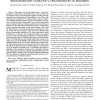Free Online Productivity Tools
i2Speak
i2Symbol
i2OCR
iTex2Img
iWeb2Print
iWeb2Shot
i2Type
iPdf2Split
iPdf2Merge
i2Bopomofo
i2Arabic
i2Style
i2Image
i2PDF
iLatex2Rtf
Sci2ools
TITB
2010
2010
Universal glucose models for predicting subcutaneous glucose concentration in humans
This paper tests the hypothesis that a "universal," data-driven model can be developed based on glucose data from one diabetic subject, and subsequently applied to predict subcutaneous glucose concentrations of other subjects, even of those with different types of diabetes. We employed three separate studies, each utilizing a different continuous glucose monitoring (CGM) device, to verify the model's universality. Two out of the three studies involved subjects with type 1 diabetes and the other one with type 2 diabetes. We first filtered the subcutaneous glucose concentration data by imposing constraints on their rate of change. Then, using the filtered data, we developed data-driven autoregressive models of order 30, and used them to make short-term, 30-min-ahead glucose-concentration predictions. We used same-subject model predictions as a reference for comparisons against cross-subject and cross-study model predictions, which were evaluated using the root-mean-squared...
| Added | 22 May 2011 |
| Updated | 22 May 2011 |
| Type | Journal |
| Year | 2010 |
| Where | TITB |
| Authors | Adiwinata Gani, Andrei V. Gribok, Yinghui Lu, W. Kenneth Ward, Robert A. Vigersky, Jaques Reifman |
Comments (0)

